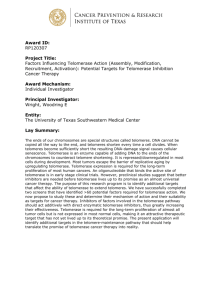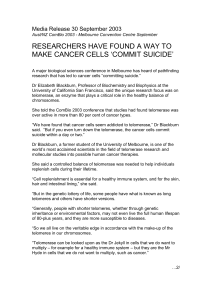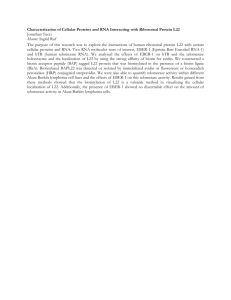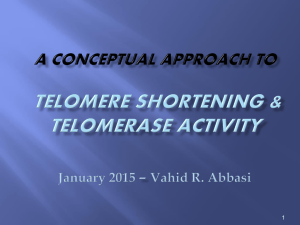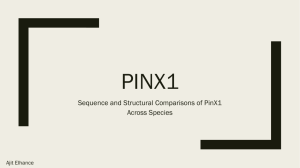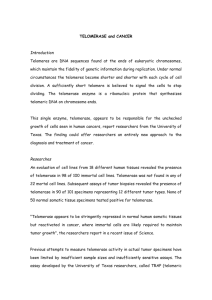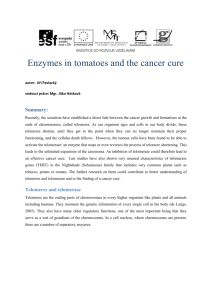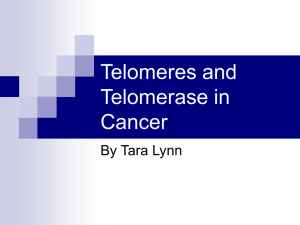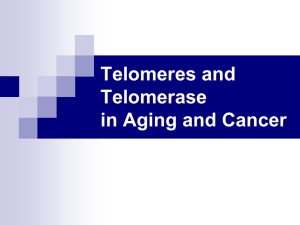Telomerase Enzyme: Analysis of the 3
advertisement
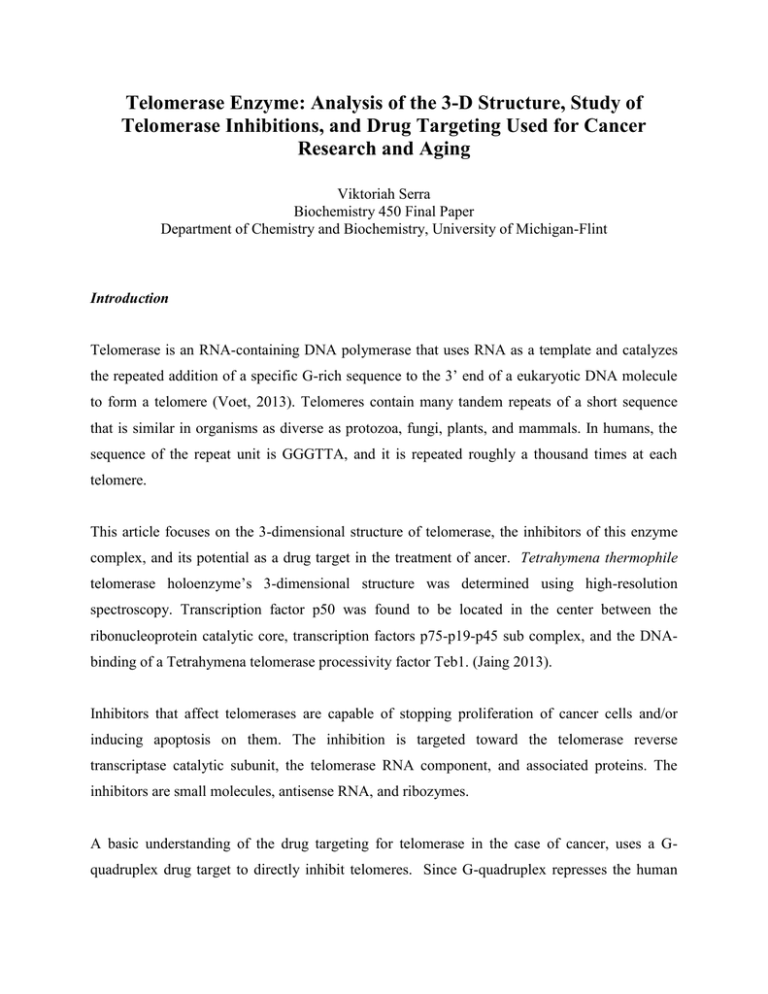
Telomerase Enzyme: Analysis of the 3-D Structure, Study of Telomerase Inhibitions, and Drug Targeting Used for Cancer Research and Aging Viktoriah Serra Biochemistry 450 Final Paper Department of Chemistry and Biochemistry, University of Michigan-Flint Introduction Telomerase is an RNA-containing DNA polymerase that uses RNA as a template and catalyzes the repeated addition of a specific G-rich sequence to the 3’ end of a eukaryotic DNA molecule to form a telomere (Voet, 2013). Telomeres contain many tandem repeats of a short sequence that is similar in organisms as diverse as protozoa, fungi, plants, and mammals. In humans, the sequence of the repeat unit is GGGTTA, and it is repeated roughly a thousand times at each telomere. This article focuses on the 3-dimensional structure of telomerase, the inhibitors of this enzyme complex, and its potential as a drug target in the treatment of ancer. Tetrahymena thermophile telomerase holoenzyme’s 3-dimensional structure was determined using high-resolution spectroscopy. Transcription factor p50 was found to be located in the center between the ribonucleoprotein catalytic core, transcription factors p75-p19-p45 sub complex, and the DNAbinding of a Tetrahymena telomerase processivity factor Teb1. (Jaing 2013). Inhibitors that affect telomerases are capable of stopping proliferation of cancer cells and/or inducing apoptosis on them. The inhibition is targeted toward the telomerase reverse transcriptase catalytic subunit, the telomerase RNA component, and associated proteins. The inhibitors are small molecules, antisense RNA, and ribozymes. A basic understanding of the drug targeting for telomerase in the case of cancer, uses a Gquadruplex drug target to directly inhibit telomeres. Since G-quadruplex represses the human telomerase reverse transcriptase protein, it is a desirable inhibitor when synergized with cytotoxic agents for immediate response in cancer cells and a future anticancer drug. Telomerase is a ribonucleoprotein complex that elongates the telomeres by adding tandem repeats of G-rich sequences to the ends of chromosomes, in a process in which the enzyme complex translocates to the new 3’ end of the DNA strand and adds the tandem repeats of the telomere sequence to the DNA. This enzyme comples comprises several subunits, which include a telomerase reverse transcriptase (TERT) protein subunits that catalyze the enzymes reactions for DNA synthesis, a telomerase RNA component that serves as template for TERT to copy, and dyskerin, which is a human telomerase RNA. The loss of telomerase function in somatic cells is the basis for aging in multicellular organisms, such loss is caused by the telomeric DNA being exposed and resulting in end-to-end fusion of the chromosomes. This causes telomerases to be highly regulated determinants of cellular aging, stem cell renewal, and tumorigenesis (Jaing 2013). Considerations on the abstract: let´s treat is as an introduction, since you are basically performing a review on the literature. Results and discussion are to be presented only if you are providing original results that were obtained by you. Since this is a review of other articles, there is no need to follow the structure introduction-materials-result-discussion. You can make a good essay by treating each topic as it would be done in a taxtbook. The 3-dimensional structure of Tetrahymena Telomerase Holoenzyme During the development of mapping the 3D structure of telomerase, several enzymes were pieced together to determine the overall shape and form of a human telomerase. Necessary structures were first understood prior to the completion of the 3D structure. These structures include the organization of TERT, TER, and p65 in the ribonucleoprotein (RNP) catalytic core. (Jaing 2013). The subunit p50 in the RNP catalytic core is located in the center between RNP, and a sub complex p75-p19-p45 commonly referred to as 7-1-14 and lastly, the DNA-binding protein Teb1. The Holoenzyme was used due to its ability to function as a multi-subunit RNP. Visual representation can be viewed in the appendix as figure 2. To begin the research on building to 3D structure, two TER regions were located in a designated location referred to as loop 4 (L4). For telomerase activity, it must be bound to the protein p65, which is located at the bottom of the TERT center. The elongation proteins 7-1-4 sub complex are still unknown on their actual function inside telomerase holoenzymes, but without them there is little to no activity of the telomerase. They are located at the top of the TERT center. Teb1 is projected from the middle layer to the right of the TERT center while p50 is also part of the middle layer and the central part of the TERT referred to as the hub. Another important part of the telomerase 3D structure is the template recognition element (TRE) that reads the DNA template for telomerase to add the Telomeric tandem repeat of the G-rich sequences. The TRE is located at the bottom near the L4 location as well as the top near the TERT ring. The U shape at the bottom of the Holoenzyme was formed by a combination of TER connected to the protein p65 in an apical loop on the loop 4. This formation is most important because it is what stimulates telomerase activity. When TERT is added to the trans binding protein p65 in the L4 region, it assembles the binding causing activity of telomerase to add the telomeres. Finally, several additional enzymes known as CTE and TRBD that cause a flaking in loop 4 cause the folding of the telomerase, which is no longer linear. Although only a broad explanation was directed toward the overall 3D structure of telomerase, the actual binding and formation can be viewed in the appendix as figure 1 and 3. Considerations on 3-d structure: the overal description was good, yet some pieces of information were found to be redundant. That is, you mentioned them in the abstract, and the introduction and her. Be careful not to repeat yourself, as it may result in you professor calling your attention to this. Telomerase Inhibitors and Drug Targeting Telomerase is an important research topic in cancer cell research. The reason for its significance is because telomerase is not detectable in somatic cells, but over expressed cancer cells. With this high affinity for cancer cells, it is a significant research topic in providing alternative methods to anticancer drugs. To prevent chromosomal end-to-end fusion, telomeres reach their critical point and form a telomere cap as well as to prevent loss of DNA. Drug targeting for telomerase was achieved using antisense oligonucleotides and ribozymes that target the telomerase mRNA or the telomerase RNA template. Although they have been proved to be catalytic inhibitors of telomerase, small molecules have a delayed effectiveness and therefore are difficult to add to a therapeutic regime. The most effective drug-targeting agent currently being researched is G-quadruplexes, which are potent inhibitors of telomerase and disrupting telomerase structures by binding to the telomeres and stabilizing secondary DNA structures (Rezler 2002). Inhibitors commonly may target five main parts of telomerases. These include the ribonucleoprotein holoenzyme, the cell signaling pathways that regulate telomerase activity, the telomerase reverse transcriptase catalytic subunit (TERT), the telomerase RNA component, and the associated proteins such as p50, p65, and 7-1-4 sub complex. A tankyrase, which is a mechanism that mediates the effectiveness of inhibited small molecules, antisense RNA, and ribozymes in the telomerase, is used to determine how effective a specific inhibitor was on the telomerase enzyme. Research for inhibiting telomerases is not as deeply studied as other overexpressed enzymes in cancer cells. Successful drug targeting agents used so far for inhibiting telomerase enzyme in cancer cells have mainly targeted the core subunits of hTERT and hTR. This is conducted by binding the inhibiting enzymes to the RNA template in the hTR subunit to inhibit transcription and negatively affect telomerase activity. In turn, the transcription template cannot reach hTERT and thus the enzyme activity is stopped and goes through cell degradation and eventually apoptosis. (Rezler 2002). Because the telomerase activity is higher in germline, cancer cells and embryonic stem cells, they are able to remain immortal. However, somatic cells have a low activity for telomerase and the length of the telomerase gradually decreases overtime until it reaches a critical point in cellular division where it can no longer replicate and is considered to be in cellular arrest that leads to apoptosis. Cancer cells or tumorigenesis, have a shorter telomere length, but because they have a high activity, they are continually expressed and cause immortality of the cell. Therefore, inhibiting the human telomerase enzyme reverse transcriptase (hTERT) catalytic subunit is considered the key catalytic component for reducing or terminating cancer cells. One method of degrading cancerous cells is by using synthetic nucleic acids that bind to the mRNA of hTERT through antisense oligodeoxynucleotides and small interfering RNAs. Antisense oligodeoxynucleotides inhibit hTERT by interfering with mRNA translation by cleaving to the hydrogen. Small interfering RNAs inhibit hTERT by shortening the doublestranded RNA molecules that form the RNA-induced silencing complex causing silencing on telomerase. This method is considered beneficial when determining short-term analysis of hTERT degradation because it effects the double-stranded RNA cells over a long period. Another method for destroying TERT is from upstream of replication. RNA interference expresses short hairpin RNA sequences in the TERT transcription effective in gene therapy, but it is a delayed inhibitor and is takes a relatively long time to notice the destruction on telomerase. Although these are just of the few inhibitors used to inhibit telomerase in cancer cells, the most promising inhibitor currently is the BIBR1532, which inhibits the in vitro processivity of telomerase. The inhibition of TERT activity with this drug occurs in a dose dependent manner and higher concentrations of this telomerase inhibitor can be cytotoxic to cancer cells of the hematopoietic system such as HL-60 cells while having little effect on normal cells. (Chen 2009). G-quadruplex-interactive drugs target the promoter region of genes such as c-MYC and become feasible as an anticancer drug when synergized with cytotoxic agents that are immediately potent to cancer cells and are less dependent on telomere length. The telomerase reverse transcriptase protein is repressed. (Rezler 2002). The drug targeting has not exceeded RNA thus far for telomerase-directed antisense strategies. Future testing plans include targeting hTERT and ribozymes to inhibit the expression of hTERT mRNA. hTERT regulation is controlled by transcriptional factors such as c-MYC, which induces telomerase activity by increasing the transcription rate. When c-MYC/MAX E-box binds with the hTERT gene promoter the expression in the telomerase of the cancer cell increases. Therefore, when the c-MYC is inhibited, it can no longer regulate the gene expression and prevents telomerase activity. The inhibitors for c-MYC are stabilized G-quadruplexes leading to the repression of the c-MYC expression. (Rezler 2002). Considerations on inhibitors: several pieces of information of this part were found to be redundant and mentioned previously. This part of the essay is pretty well done. Also, the term is “inhibitors”, since they are drugs that inhibit the enzyme activity of telomerase. Future perspectives Screening for potential merging in telomerase inhibition for conventional chemotherapy is the ultimate goal for drug targeting and inhibition of telomerase. A promising approach in the future may contain combination therapy where many anti-telomerase approaches are combined together to form an effective anticancer drug. Once the inhibitors are conducted in vivo, a better understanding of how they will affect the body apart from the telomerase will further be studied before considering an effective telomerase-targeting treatment for cancer. Considerations to future perspectives: as this is a review, the part regarding discussion can be skipped. Some redundant pieces of information were removed. However, you have a great chance here to look for information regarding current and future trends in research concerning telomerase and treatment of cancer. LITERATURE CITED 1. Jiang, J.; Miracco, E.J.; Hong, K.; Echkert, B.; Chan, H.; Cash, D.D.; Min, B.; Zhou, Z.H.; Collins, K.; Feigon, J. Nature. The Architecture of Tetrahymena Telomerase Holoenzyme. 2013, 496, 187-192. 2. Rezler, E. M.; Bearss, D. J.; Hurley, L. H. Science Direct. Telomeres and Telomerases as drug targets. 2002, 2, 4, 415-423. 3. Cian, A. D.; Lacroix, L.; Douarre, C.; Temime-smaali, N.; Trentesaux, C.; Riou, J. F.; Mergny, J. L. Science Direct. Targeting Telomeres and telomerases. 2008, 90, 1, 131-155. 4. Blackburn, E. H. Annu. Rev. Biochem. Telomerases. 1992, 61, 113-129. 5. Chen, H.; Li, Y.; Tollefsbol, T. O. Rev. Mol. Biotechnol. Strategies Targeting Telomerase Inhibition. 2009, 2, 194-199. 6. Hahn, W. C.; Stewart, S. A.; Brooks, M. W.; York, S. G.; Eaton, E.; Kurachi, A.; Beijersbergen, R. L.; Knoll, J. H. M.; Meyerson, M.; Weinberg, R. A. Nature. Inhibition of Telomerase Limits the Growth of Human Cancer Cells. 1999, 5, 10, 1164-1170. 7. Theimer, C. A.; Blois, C. A.; Feigon, J. Science Direct. Structure of the Human Telomerase RNA Pseudoknot Reveals Concserved Tertiary Interactions Essential for Function. 2005, 17, 5, 671-682. 8. Theimer, C. A.; Feigon, J. Science Direct. Structure and Function of Telomerase RNA. 2006, 16, 3, 307-318. 9. O’Connor, C. M.; Collins, K. Mol. Cell. Biol. A Novel RNA Binding Domain in Tetrahymena Telomerase p65 Inititates Hierachical Assembly of Telomerase Holoenzyme. 2006, 26, 6, 2029-2036. APPENDICES Figure 1: structure of the RNP catalytic core. Figure 2: Structural conformations of the 7-1-4 subcomplexes. Figure 3: 3D mapping of the Catalytic Core.
